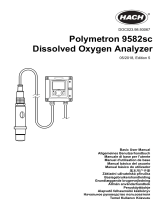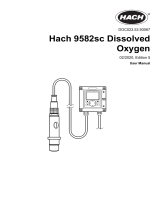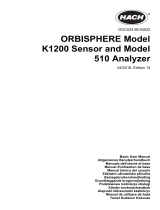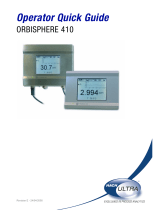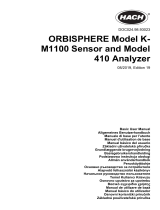Page is loading ...

Model DO-03/04
Dissolved Oxygen Measurement System
with Air Blast Cleaner
Instruction Manual
51-DO-03/04/rev.C
October 2004

ESSENTIAL
INSTRUCTIONS
READ THIS PAGE BEFORE PROCEEDING!
Rosemount Analytical designs, manufactures, and tests its products to
meet many national and international standards. Because these instru-
ments are sophisticated technical products, you must properly install, use,
and maintain them to ensure they continue to operate within their normal
specifications. The following instructions must be adhered to and integrat-
ed into your safety program when installing, using, and maintaining
Rosemount Analytical products. Failure to follow the proper instructions
may cause any one of the following situations to occur: Loss of life; per-
sonal injury; property damage; damage to this instrument; and warranty
invalidation.
• Read all instructions prior to installing, operating, and servicing the prod-
uct. If this Instruction Manual is not the correct manual, telephone 1-
800-654-7768 and the requested manual will be provided. Save this
Instruction Manual for future reference.
• If you do not understand any of the instructions, contact your
Rosemount representative for clarification.
• Follow all warnings, cautions, and instructions marked on and supplied
with the product.
• Inform and educate your personnel in the proper installation, operation,
and maintenance of the product.
• Install your equipment as specified in the Installation Instructions of the
appropriate Instruction Manual and per applicable local and national
codes. Connect all products to the proper electrical and pressure
sources.
• To ensure proper performance, use qualified personnel to install, oper-
ate, update, program, and maintain the product.
• When replacement parts are required, ensure that qualified people use
replacement parts specified by Rosemount. Unauthorized parts and
procedures can affect the product’s performance and place the safe
operation of your process at risk. Look alike substitutions may result in
fire, electrical hazards, or improper operation.
• Ensure that all equipment doors are closed and protective covers are in
place, except when maintenance is being performed by qualified per-
sons, to prevent electrical shock and personal injury.
W
ARNING
ELECTRICAL SHOCK HAZARD
Making cable connections to and servicing this instru-
ment require access to shock hazard level voltages
which can cause death or serious injury, therefore,
disconnect all hazardous voltage before accessing
the electronics.
Relay contacts made to separate power sources must
be disconnected before servicing.
Electrical installation must be in accordance with the
National Electrical Code (ANSI/NFPA-70) and/or any
other applicable national or local codes.
Unused cable conduit entries must be securely sealed
by non-flammable closures to provide enclosure
integrity in compliance with personal safety and envi-
ronmental protection requirements. Use NEMA 4X or
IP65 conduit plugs supplied with the instrument to
maintain the ingress protection rating (IP65).
For safety and proper performance this instrument
must be connected to a properly grounded three-wire
power source.
Proper relay use and configuration is the responsibili-
ty of the user. No external connection to the instru-
ment of more than 60VDC or 43V peak allowed with
the exception of power and relay terminals. Any viola-
tion will impair the safety protection provided.
Do not operate this instrument without front cover
secured. Refer installation, operation and servicing to
qualified personnel.
WARNING
This product is not intended for use in the resi-
dential, commercial or light industrial environ-
ment per certification to EN61326.
Emerson Process Management
Rosemount Analytical Inc.
2400 Barranca Parkway
Irvine, CA 92606 USA
Tel: (949) 757-8500
Fax: (949) 474-7250
http://www.raihome.com
© Rosemount Analytical Inc. 2004
About This Document
This manual contains instructions for installation and operation of the Model DO-03/04. The following
list provides notes concerning all revisions of this document.
Rev. Level Date Notes
A 1/04 This is the initial release of the product manual. The manual has been reformatted to reflect the
Emerson documentation style and updated to reflect any changes in the product offering.
B 5/04 Drawings and part numbers were updated on pages 5, 6, 7, and 51.
C 10/04 Updated Specifications, Section 1.0.


MODEL DO-03/04 TABLE OF CONTENTS
MODEL DO-03/04 MEASURING SYSTEM
TABLE OF CONTENTS
Section Title Page
1.0 SPECIFICATIONS................................................................................................... 1
1.1 Features and Applications ....................................................................................... 1
1.2 Specifications........................................................................................................... 2
1.3 Ordering Information................................................................................................ 6
2.0 INSTALLATION....................................................................................................... 7
2.1 Unpacking and Inspection ....................................................................................... 7
2.2 Installation................................................................................................................ 7
3.0 WIRING ................................................................................................................... 12
3.1 General.................................................................................................................... 12
3.2 Power, Alarm, and Output Wiring ............................................................................ 12
3.3 Sensor Wiring .......................................................................................................... 16
4.0 DISPLAY AND OPERATION................................................................................... 17
4.1 Display.....................................................................................................................17
4.2 Key Functions and Control ...................................................................................... 17
4.3 Alarm Status ............................................................................................................ 17
5.0 SOFTWARE CONFIGURATION ............................................................................. 18
5.1 Changing Alarm Setpoints....................................................................................... 24
5.2 Ranging the Outputs................................................................................................ 25
5.3 Testing Outputs and Alarms .................................................................................... 26
5.4 Choosing Display Options ....................................................................................... 27
5.5 Changing Output Parameters.................................................................................. 29
5.6 Changing Alarm Parameters ................................................................................... 31
5.7 Temperature Compensation and Temperature Units............................................... 35
5.8 Noise Reduction ...................................................................................................... 36
5.9 Barometric Pressure................................................................................................ 37
5.10 Main Sensor Calibration Parameters ...................................................................... 38
5.11 Security.................................................................................................................... 39
5.12 Analyzer Mode Priority ............................................................................................ 40
6.0 CALIBRATION - TEMPERATURE.......................................................................... 41
6.1 Introduction.............................................................................................................. 41
6.2 Temperature Calibration .......................................................................................... 42
7.0 CALIBRATION - DISSOLVED OXYGEN................................................................ 43
7.1 Introduction.............................................................................................................. 43
7.2 Zeroing the Sensor.................................................................................................. 44
7.3 Calibrating the Sensor in Air.................................................................................... 45
7.4 Calibrating the Sensor Against a Standard Instrument ........................................... 47
7.5 Calibrating Barometric Pressure.............................................................................. 48
8.0 CALIBRATION - CURRENT OUTPUTS................................................................. 49
8.1 Introduction.............................................................................................................. 49
8.2 Trimming the Outputs .............................................................................................. 49
i

9.0 MAINTENANCE ...................................................................................................... 50
9.1 Analyzer (Model 54eA-01)....................................................................................... 50
9.2 Oxygen Sensor (Model 499ADO-54) ...................................................................... 50
9.3 Air Compressor........................................................................................................ 52
9.4 Air Blast Sensor Washer ......................................................................................... 53
10.0 TROUBLESHOOTING ............................................................................................ 54
10.1 Overview.................................................................................................................. 54
10.2 Troubleshooting When a Fault Message is Showing .............................................. 54
10.3 Troubleshooting When No Fault Message is Showing - Temperature.................... 56
10.4 Troubleshooting When No Fault Message is Showing - Oxygen............................ 56
10.5 Troubleshooting Not Related to Measurement Problems ....................................... 59
10.6 Simulating Inputs - Dissolved Oxygen..................................................................... 59
10.7 Simulating Temperature........................................................................................... 60
11.0 RETURN OF MATERIALS...................................................................................... 61
LIST OF TABLES
Table No. Title ......................................................................................................................... Page
5-1 Program Settings List .............................................................................................. 21
5-2 Controller Mode Priority Chart................................................................................. 40
9-1 Replacment Parts .................................................................................................... 50
ii
MODEL DO-03/04 TABLE OF CONTENTS
TABLE OF CONTENTS (CONTINUED)
Section Title Page

iii
MODEL DO-03/04 TABLE OF CONTENTS
LIST OF FIGURES
Section Title Page
1-1 Suggested Arrangement of Handrail Mounting Assembly, Maintenance Clamp,....
Air Compressor Enclosure, and 54eA Analyzer ...................................................... 4
1-2 Analyzer Dimensions............................................................................................... 4
1-3 Enclosure Dimensions............................................................................................. 5
1-4 Standard Sensor with Integral Cable....................................................................... 5
1-5 Air Blast Washer Head ............................................................................................ 5
2-1 Suggested Arrangement of Handrail Mounting Assembly, Maintenance Clamp,....
Air Compressor Enclosure, and 54eA Analyzer ...................................................... 8
2-2 Pipe Mounting.......................................................................................................... 8
2-3 Attaching the Air Compressor Enclosure to the Handrail........................................ 10
2-4 Assembling and Attaching the Handrail Mounting Assembly .................................. 10
2-5 Installing the Sensor in the Washer Head Assembly .............................................. 11
3-1 Power Input, Relay, and Output Wiring for 54eA Analyzer...................................... 13
3-2 Model DO-03 — Wiring Air Blast Compressor to Model 54eA Analyzer 115 Vac .. 14
3-3 Model DO-04 — Wiring Air Blast Compressor to Model 54eA Analyzer 230 Vac.. 15
3-4 Wiring Label............................................................................................................. 16
3-5 Oxygen Sensor with Standard Cable ...................................................................... 16
3-6 Oxygen Sensor with Optimum EMI/RFI Cable or Variopol Cable ........................... 16
4-1 Main Display Screen................................................................................................ 17
5-1 Menu Tree for the 54eA Analyzer............................................................................ 18
5-2 Low Alarm................................................................................................................ 32
5-3 High Alarm ............................................................................................................... 32
5-4 Interval Timer .......................................................................................................... 34
7-1 Sensor Current as a Function of Dissolved Oxygen Concentration ....................... 43
9-1 Sensor Parts............................................................................................................ 52
9-2 Replacement Parts .................................................................................................. 53
10-1 Simulate Dissolved Oxygen..................................................................................... 59
10-2 Three-Wire RTD Configuration................................................................................ 60
10-3 Simulating RTD Inputs............................................................................................. 60

1
MODEL DO-03/04 SECTION 1.0
SPECIFICATIONS
SECTION 1.0
SPECIFICATIONS
• COMPLETE SYSTEM INCLUDES sensor, analyzer, sensor washer head, mounting hard-
ware, and air compressor.
• AIR BLAST CLEANER system can keep DO sensors funtioning up to 3 months or
longer.
• SENSOR MAINTENANCE is quick and easy.
• FEATURE-PACKED ANALYZER: on-board pressure sensor for completely automatic air
calibration, large backlit display, dual outputs, three fully programmable alarm relays.
FEATURES AND BENEFITS
The Model DO-03/04 is a complete system for the determination of dissolved oxygen in wastewater aeration
basins. It consists of a sensor, an analyzer, a handrail mounting assembly, a sensor washer head, and an air
compressor. A timer in the analyzer allows the user to customize the air blast cleaning cycle.
The Model DO-03/04 uses a membrane-covered amperometric sensor. A polarizing voltage applied to a gold
cathode behind the membrane destroys oxygen diffusing through the membrane and keeps the concentration of
oxygen in the sensor equal to zero. The current generated by the cathode reaction is proportional to the rate of
diffusion of oxygen through the membrane. Because the concentration of oxygen in the sensor is zero, the diffu-
sion rate and the current are proportional to the concentration of oxygen in the sample.
Sensor maintenance is fast and easy. Replacing a membrane requires no special tools or fixtures. A screw cap
holds the pre-tensioned membrane in place. Replacing the electrolyte solution takes only minutes.
The Model DO-03/04 includes the rugged, easy-to-use Model 54eA analyzer. The analyzer features two fully pro-
grammable 4-20 mA outputs, and three fully programmable alarm relays. The backlit three line display allows the
user to read oxygen levels at a glance. The analyzer permits both air calibration and calibration against a labora-
tory instrument. Air calibration is completely automatic. All the user does is expose the sensor to water-saturated
air and press a few buttons.
The Air Blast Sensor Cleaner, which includes the washer head and air compressor, keeps the sensor membrane
clean, helping ensure reliable, trouble-free oxygen measurements and reducing sensor cleaning maintenance to
as little as every three months. At programmed intervals, the air blast cleaner blows a stream of air across the
membrane to clear bio-film from on the membrane. The frequency and duration of the air blast is programmable
from the 54eA analyzer.
The photograph shows a sensor after nine weeks in an aeration basin. The cathode is clearly visible under the
membrane. A 60-second air blast every eight hours is keeping the membrane clean.
Plant service air can be used in place of the air compressor. The 54eA analyzer relay is then used to operate a
solenoid valve.

MODEL DO-03/04 SECTION 1.0
SPECIFICATIONS
2
SPECIFICATIONS - 499ADO-54 SENSOR
Range: 0 to 20 ppm (mg/L)
Wetted parts: Noryl
1
Viton
2
EPDM, Teflon
3
, silicone
Cathode: Gold (not normally wetted)
Accuracy: ±0.2 ppm at 25°C
Repeatability: ±0.05 ppm 25°C
Response time: 25 sec to 63% of final reading at 25°C
Pressure: 0 to 65 psig (0 to 549 kPa abs)
Temperature: 32 to 122°F (0 to 50°C)
Process connection: 1 inch MNPT
Electrolyte volume: 25 mL (approx.)
Cable length (standard): 25 ft (7.6 m)
Cable length (maximum): 300 ft (91 m)
SPECIFICATIONS - 54EA-01 ANALYZER
Enclosure: Epoxy-painted (light gray) cast aluminum,
NEMA 4X (IP65). 144 x 144 x 132 mm
(5.7 x 5.7 x 5.2 in.), DIN size panel cut-out.
Front Panel: Membrane keypad with tactile feedback.
Three green LEDs indicate alarm status. Red
LED indicates fault condition.
Display: Three-line, back-lit, dot matrix LCD, 70 x 35 mm.
First line is oxygen reading. Second line is tem-
perature and current output. Third line is user-
selectable. Character heights: 1st line - 16 mm
(0.6 in.), 2nd and 3rd lines - 7 mm (0.3 in.).
Power:
115 VAC ± 10%, 50/60 Hz ± 6%, 8 W
230 VAC ± 10%, 50/60 Hz ± 6%, 8 W
RFI/EMI: EN-61326
LVD: EN-61010-1
Outputs: Two 4-20 mA or 0-20 mA isolated outputs.
Continuously adjustable. Outputs can be assigned
to oxygen or temperature. Output dampening is
user-selectable. Maximum load at 100/200 Vac is
550 ohms.
Output Accuracy: ± 0.05 mA
Alarms: Relays 1, 2, and 3 are assignable to oxygen
or temperature. One relay can also be used as
an interval timer to operate the air blast cleaner.
Relay 4 - Sensor/analyzer fault alarm
Each relay has a dedicated LED on the front panel.
Relay Contacts: Relays 1-3: Epoxy sealed form A
contacts, SPST, normally open
Relay 4: Epoxy sealed form C, SPDT
Resistive
Inductive
115 Vac 5.0 Amps 3.0 Amps
230 Vac 5.0 Amps 1.5 Amps
Ambient Temperature: 0 to 50°C (32 to 122°F).
Analyzer can be operated between -20 and 60°C
(-4 to 140°F) with some degradation in display
quality.
Relative Humidity: 95% (maximum) non-condensing
Temperature correction for membrane permeability:
automatic between 0 and 50°C.
Calibration: automatic air calibration or calibration
against a standard instrument
Pressure sensor range: 113 to 862 mm Hg (150 to
1150 mbar)
1
Noryl is a registered trademark of General Electric
2
Viton is a registered trademark of E.I. duPont de Nemours & Co.
3
Teflon is a registered trademark of E.I. duPont de Nemours & Co.

MODEL DO-03/04 SECTION 1.0
SPECIFICATIONS
3
SPECIFICATIONS - COMPRESSOR FOR
AIR BLAST CLEANER SYSTEM
Enclosure: Fiberglass reinforced polyester with poly-
ester cover, NEMA 4x (IP65). 11.9 x 11.9 x 6.9 in
(302 x 302 x 175 mm).
Compressor: Oil-less, non-lubricating piston and
cylinder. 1/12 HP permanent split capacitor motor
with thermal overload protection.
Maximum continuous pressure: 50 psig
(446 kPa abs)
Operating pressure: 20 psig (239 kPa abs)
Air hose: 25 ft (7.6 m) included with ABSH
Ambient temperature: 5 to 122°F (-15 to 50°C)
assuming intermittent operation
Power:
Code -03: 115 VAC, 60 Hz or 100
VAC, 50/60 Hz, single phase,1.3 to
1.4 A, starting current 3.88 A, insu-
lation class B; UL approved
Code -04: 220 VAC, 50 Hz, single
phase, 0.6 A, starting current 1.5 A,
insulation class A; CE approved
SPECIFICATIONS - AIR BLAST CLEANER
SYSTEM WASHER HEAD
Process connection: 1-1/2 inch PVC pipe socket
Dimensions (diameter x length): 2-1/2 x 10-3/4
inches (64 x 273 mm)
Wetted materials: PVC, Noryl, Viton
Pipe boom: 1-1/2 inch schedule 80 PVC, maximum
length 12 feet (3.6 m) past handrail mounting clamp.
Pipe boom is supplied by customer.
Maximum distance between compressor and sensor:
25 ft (7.6 m). ABSH is supplied with 25 ft (7.6 m) of air
hose.
SPECIFICATIONS - HANDRAIL MOUNTING
ASSEMBLY
Materials of Construction:
Weather cap: Schedule 40 PVC
Pipe clamp and bracket: Aluminum
Clevis: zinc-plated steel
U-bolts, nuts, and bolts: zinc-plated steel
Washers: stainless steel
SHIPPING INFORMATION
The Model DO-03/04 is shipped in a single container.
Shipping weight is 38 lbs (17.5 kg).
PLANT AIR SYSTEM REQUIREMENTS
(for customers using plant air in place of
air compressor)
Pressure: 20 psig (239 kPa abs)
Flow: 0.50 SCFM (14 L/min at STP)
Air hose: (customer supplied) compatible with ¼ inch
barbed fitting for connection at washer head

MODEL DO-03/04 SECTION 1.0
SPECIFICATIONS
4
FIGURE 1-2. Analyzer dimensions
WHEN INCH AND METRIC DIMS
ARE GIVEN
MILLIMETER
INCH
FIGURE 1-1. Suggested arrangement of handrail mounting assembly, maintenance clamp,
air compressor enclosure, and 54eA analyzer

MODEL DO-03/04 SECTION 1.0
SPECIFICATIONS
FIGURE 1-3. Enclosure dimensions
WHEN INCH AND METRIC DIMS
ARE GIVEN
INCH
MILLIMETER
FIGURE 1-4. Standard sensor with
integral cable
FIGURE 1-5. Air blast washer head
5

6
MODEL DO-03/04 SECTION 1.0
SPECIFICATIONS
ORDERING INFORMATION
The Model DO -03/04 is a complete system for the determination of oxygen in wastewater aeration basins. It
consists of a 54eA analyzer, a 499ADO-54 oxygen sensor, an air blast washer head with air compressor and
hose, and a handrail mounting bracket. All hardware necessary to mount the analyzer and the air compressor
enclosure on a handrail is provided. Cable gland fittings for the analyzer are also supplied. Three replacement
membranes and a bottle of electrolyte solution are shipped with the sensor. Pipe boom is supplied by customer.
MODEL Description
DO Dissolved Oxygen Measuring System
CODE Power (required selection)
-03 115 Vac, 60 Hz or 100 Vac, 50/60 Hz
-04 220 Vac, 50 Hz
Part # DESCRIPTION
9240048-00 Tag, stainless steel, specify marking
MODEL DO DISSOLVED OXYGEN MEASURING SYSTEM WITH AIR BLAST CLEANER
DO -03 EXAMPLE
ACCESSORIES FOR 54eA ANALYZER
Part # DESCRIPTION
23502-00 Membrane replacement kit with O-ring, qty 3
9210264 Amperometric sensor fill solution #1, 4 oz (120 mL)
CONSUMABLES FOR SENSOR
54e-A-01 Model 54eA analyzer
2002577 Mounting bracket for Model 54e, pipe/wall
23554-00 Cable glands kit for Model 54e, qty 5
499ADO-54 Model 499ADO oxygen sensor
24057-00 Smooth membrane retainer for 499ADO sensor
HRMS-02 Handrail clamp assembly for washer head (clamp, sensor maintenance kit, and elbow)
9320101 Elbow, 90° female socket, PVC schedule 40
24049-00 Air blast washer head
9160549 Air hose, 1/4-inch ID x 1/2-inch OD, 25 ft (7.6 m)
Customers using plant compressed air should order the following items in place of Model -03/04:
9380088 Air compressor; 115 Vac, 60 Hz or 100 Vac, 50/60 Hz
9380089 Air compressor; 220 Vac, 50 Hz
24051-00 Mounting hardware for air compressor enclosure
24053-00 O-ring kit for sensor washer head (three O-rings and lube)
REPLACMENT PARTS AND ACCESSORIES

7
MODEL DO-03/04 SECTION 2.0
INSTALLATION
SECTION 2.0
INSTALLATION
2.1 UNPACKING AND INSPECTION
Inspect the shipping container. If it is damaged, contact the shipper immediately for instructions. If there is no
apparent damage, unpack the container. Be sure all items shown on the packing list are present. If items are
missing, notify Rosemount Analytical immediately.
The Model DO-03/04 consists of the following items.
The customer must supply a schedule 80 1-1/2 inch PVC pipe boom to immerse the sensor and cleaning head in
the aeration basin.
2.2 INSTALLATION
2.2.1 General information
1. Although the equipment is suitable for outdoor use, do not install it in direct sunlight or in areas of extreme
temperatures.
2. Install the equipment in an area where vibrations and electromagnetic and radio frequency interference are
minimized or absent.
3. To keep the analyzer watertight, install plugs (provided) in the unused cable openings.
4. Keep the analyzer and sensor wiring at least one foot from high voltage conductors. Be sure there is easy
access to the analyzer.
5. Provide room to allow the sensor and attached piping to be removed from the aeration basin for service. A
maintenance bracket (part of PN 24048-00) can be used to rest the PVC pipe boom on the handrail.
Figure 2-1 shows the suggested arrangement of the analyzer, air compressor, and maintenance bracket on the
handrail.
Model or part number Description
54e-A-01 Model 54eA analyzer
2002577 Mounting bracket for Model 54e, pipe/wall
23544-00 Cable glands kit for Model 54e, qty 5
499ADO-54 Model 499ADO oxygen sensor
24057-00 Smooth membrane retainer for 499ADO sensor
HRMS-02 Handrail clamp assembly (clamp, sensor maintenance kit, and elbow)
24049-00 Air blast washer head
24050-00 Air compressor and enclosure with air hose (115 VAC) option -03 only
24050-01 Air compressor and enclosure with air hose (220 VAC) option -04 only
24051-00 Mounting hardware for air compressor enclosure
24053-00 O-ring kit for sensor washer head (three O-rings and lube)

2.2.2 Installing the analyzer
When used in Model DO-03/04, the 54eA analyzer is intend-
ed to be mounted on the basin handrail. See Figures 2-1
and 2-2.
2.2.3 Installing the air compressor enclosure
The air compressor is in a NEMA 4X fiberglass enclosure.
Figure 2-3 shows how to attach the enclosure to a handrail.
1. Locate the enclosure within 25 ft (7.6 m) of the sensor.
2. Be sure the ambient temperature is between 5 and
122°F (-15 to 50°C). Do not expose the enclosure to
direct sunlight. The operating temperature for the air
compressor might be exceeded.
2.2.4 Installing the handrail mounting assembly
The handrail mounting assembly (PN 24048-00) is shipped completely disassembled. Assemble and attach the
mounting assembly to the handrail. Refer to Figure 2-4. The spring pin shipped with the handrail mounting
assembly is not needed. Do not attach the boom clamp to the clevis yet. Attach the maintenance bracket (PN
24044-00) to the handrail. See Figure 2-1.
2.2.5 Assembling the pipe and pipe clamp
Slide the PVC pipe boom through the handrail mounting pipe clamp. Tighten the bolt to keep the clamp from
sliding off. Use 1-1/2 inch schedule 80 PVC piping. Distance between the clamp and the end of the pipe should
not exceed 12 feet (3.6 m). See Figures 2-1 and 2-4.
8
FIGURE 2-2. Pipe Mounting
MODEL DO-03/04 SECTION 2.0
INSTALLATION
FIGURE 2-1. Suggested arrangement of handrail mounting assembly, maintenance clamp,
air compressor enclosure, and 54eA analyzer.

9
MODEL DO-03/04 SECTION 2.0
INSTALLATION
2.2.6 Installing the sensor in the washer head assembly
1. Remove the sensor from its box. Remove the plastic protective cap from the end of the sensor. Save the
cap.
2. Replace the knurled cap provided with the sensor with the smooth cap (PN 33521-01). The smooth cap is
shipped loose.
a. Hold the sensor with the membrane end pointing up.
b. Unscrew the knurled cap. Leave the membrane in place.
c. Screw the smooth cap in place. Hand tighten.
d. Hold the sensor with the membrane end pointing down. Shake the sensor a few times as though shak-
ing down a clinical thermometer.
e. Slide the protective cap back over the end of the sensor.
3. Remove the set screw at the bottom of the sensor washer head assembly. See Figure 2-5. Pull the washer
head from the shank. You are pulling against a dual O-ring seal.
4. Press the metal tab on the air hose quick connect fitting and remove the fitting and check valve.
5. Wrap the bottom facing threads of the sensor with pipe tape. Remove the protective cap and slide the O-ring
(PN 9550291) over the end of the sensor until it rests against the lower edge of the bottom facing thread.
The O-ring is in a bag taped to the side of the washer head assembly.
6. Screw the sensor into the bottom of the washer assembly. Hand tighten only. Replace the air hose and
check valve assembly.
2.2.7 Assembling the washer head and pipe boom
1. Cement the upper portion of the washer assembly head to the PVC pipe boom. See Figure 2-5. Use 1-1/2
inch schedule 80 PVC pipe. Press (do not cement) the PVC elbow (PN 9320101) to the top of the pipe
boom. The elbow keeps water from collecting in the pipe boom.
2. Pass the sensor cable and air hose through the boom and elbow.
3. Connect the end of the air hose to the barbed fitting on the check valve.
4. Push the washer head back onto the shank. Use a small amount of grease to lubricate the O-rings. Replace
and tighten the set screw.
2.2.8 Attaching the pipe boom to the handrail mounting assembly
1. Slide the tongue of the pipe clamp into the clevis. Insert the bolt as shown in Figure 2-3.
2. Rest the boom on the maintenance bracket until ready to submerge the sensor in the basin.

10
MODEL DO-03/04 SECTION 2.0
INSTALLATION
FIGURE 2-3. Attaching the air compressor enclosure to the handrail
FIGURE 2-4. Assembling and attaching the handrail mounting assembly.
The spring pin (not shown) shipped with the handrail mounting assembly is not used.

MODEL DO-03/04 SECTION 2.0
INSTALLATION
FIGURE 2-5. Installing the sensor in the washer head assembly
11

12
MODEL DO-03/04 SECTION 3.0
WIRING
SECTION 3.0
WIRING
3.1 GENERAL
WARNING
Electrical installation must conform to the National Electrical Code, all state and local codes, and all plant
codes and standards for electrical equipment. Electrical installation and wiring must be done by qualified
personnel.
The five holes in the bottom of the Model 54eA enclosure accept 1/2-in. (PG-13.5) strain relief connectors or con-
duit fittings. The rear openings are for power and alarm relay wiring. The left front opening is for sensor wiring and
the right front opening is for analog output wiring. Seal unused openings with conduit plugs.
3.2 POWER, ALARM, AND OUTPUT WIRING
Figure 3-1 shows the power, relay, and current output terminals. For access to the terminals, loosen the screw hold-
ing the protective cover in place and remove the cover. Make power and alarm connections on TB3. Make analog
output wiring connections on TB2.
DANGER
Live voltages may be present.
Will cause severe injury or death.
Alarm contacts are dry (i.e., not powered) and are normally open. Refer to Section 1.0 for relay specifications.
Refer to Figure 3-2 or 3-3 for details on how to wire the Model ABSH (air blast system) to the 54eA analyzer. Figure
3-2 is for Model DO-03 (115 Vac 60 Hz). Figure 3-3 is for Model DO-04 (220 Vac 50 Hz).
NOTE
The 54eA analyzer has four alarm relays. Relays 1, 2, or 3 are normally open (NO) and can be used to
operate the air blast cleaner. The wiring diagrams show alarm relay 3 being used. The relay used for the
air blast cleaner MUST be configured as an interval timer. See Section 5.6 for programming details.
For best EMI/RFI protection, shield the output cable and enclose it in an earth-grounded, rigid, metal conduit.
Connect the outer shield of the output cable to the earth ground connection on TB2 (see Figure 3-1).
Keep sensor and output signal wiring separate from power wiring. Do no run sensor and power cables in the same
conduit or close together in a cable tray.
AC wiring must be 14 gauge or greater. Be sure to connect earth ground from the power cable to the nearby
ground lug. A good earth ground is necessary for proper operation of the analyzer. Provide a switch or breaker to
disconnect the analyzer from the main power supply. Install the switch or breaker near the analyzer and label it as
the disconnecting device.
WARNING: RISK OF ELECTRICAL SHOCK
AC connections and grounding must comply with UL 508 or local electrical code. DO NOT apply
power to the analyzer until all electrical connections are verified and secure.

13
MODEL DO-03/04 SECTION 3.0
WIRING
FIGURE 3-1. Power Input, Relay, and Output Wiring for 54eA analyzer
DWG. NO. REV.
454EPH02 D

14
MODEL DO-03/04 SECTION 3.0
WIRING
FIGURE 3-2. Model DO-03 — Wiring Air Blast Compressor to Model 54eA Analyzer 115 Vac
/
